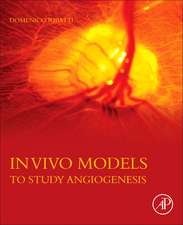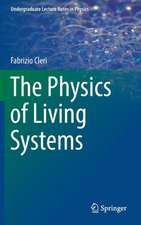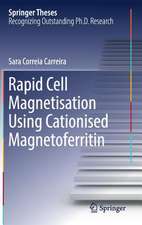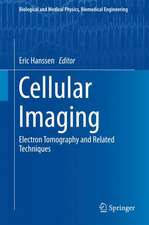Optical Interferometry for Biology and Medicine: Bioanalysis, cartea 1
Autor David D. Nolteen Limba Engleză Hardback – 3 dec 2011
Optical Interferometry for Biology and Medicine is divided into four sections. The first covers fundamental principles, and the next three move up successive scales, beginning with molecular interferometry (biosensors), moving to cellular interferometry (microscopy), and ending with tissue interferometry (biomedical). An outstanding feature of the book is the clear presentation of the physics, with easy derivations of the appropriate equations, while emphasizing "rules of thumb" that can be applied by experimental researchers to give semi-quantitative predictions.
| Toate formatele și edițiile | Preț | Express |
|---|---|---|
| Paperback (1) | 947.85 lei 6-8 săpt. | |
| Springer – 23 aug 2016 | 947.85 lei 6-8 săpt. | |
| Hardback (1) | 952.09 lei 6-8 săpt. | |
| Springer – 3 dec 2011 | 952.09 lei 6-8 săpt. |
Preț: 952.09 lei
Preț vechi: 1161.08 lei
-18% Nou
Puncte Express: 1428
Preț estimativ în valută:
182.21€ • 189.52$ • 150.42£
182.21€ • 189.52$ • 150.42£
Carte tipărită la comandă
Livrare economică 14-28 aprilie
Preluare comenzi: 021 569.72.76
Specificații
ISBN-13: 9781461408895
ISBN-10: 146140889X
Pagini: 552
Ilustrații: XII, 354 p.
Dimensiuni: 155 x 235 x 28 mm
Greutate: 0.64 kg
Ediția:2012
Editura: Springer
Colecția Springer
Seria Bioanalysis
Locul publicării:New York, NY, United States
ISBN-10: 146140889X
Pagini: 552
Ilustrații: XII, 354 p.
Dimensiuni: 155 x 235 x 28 mm
Greutate: 0.64 kg
Ediția:2012
Editura: Springer
Colecția Springer
Seria Bioanalysis
Locul publicării:New York, NY, United States
Public țintă
ResearchCuprins
Part I. Fundamentals of Biological Optics.- CHAPTER 1. INTERFEROMETRY.- CHAPTER 2. DIFFRACTION AND LIGHT SCATTERIN.- CHAPTER 3. SPECKLE AND SPATIAL COHERENCE.- CHAPTER 4. SURFACE OPTICS.- Part II. Molecular Interferometry and Biosensors.- CHAPTER 5. INTERFEROMETRIC THIN FILM OPTICAL BIOSENSORS.- CHAPTER 6. DIFFRACTIONBASED INTERFEROMETRIC BIOSENSORS.- CHAPTER 7. INTERFEROMETRIC WAVEGUIDE SENSORS.- Part III. Cellular Interferometry.- CHAPTER 8. CELL STRUCTURE AND DYNAMICS.- CHAPTER 9. INTERFERENCE MICROSCOPY.- Part IV. Interferometry of Biological Tissues.- CHAPTER 10. LIGHT PROPAGATION IN TISSUE.- CHAPTER 11. OPTICAL COHERENCE TOMOGRAPHY.- CHAPTER 12. HOLOGRAPHY OF TISSUES.- CHAPTER 13. APPENDIX: MATHEMATICAL FORMULAS.
Notă biografică
David D. Nolte is a professor of Physics at Purdue University, working in the field of holographic optics and biophotonics. He has been elected a Fellow of the Optical Society of America and a Fellow of the American Physical Society. He was a Research Fellow of the Alfred P. Sloan Foundation, and a Presidential Young Investigator of the National Science Foundation. In 2005 he received the Herbert Newby McCoy Award, the highest scientific honor awarded by Purdue University.
David received his baccalaureate from Cornell University in 1981 and his Ph.D from the University of California at Berkeley in 1988. He is the author of over two hundred journal papers, book chapters and encyclopedia articles, and has secured a dozen US patents in applied optics and biophotonics.
David is also the author of the trade non-fiction book Mind at Light Speed published in 2001 by Free Press, which describes the history and technology of optical telecommunications. He is a popular lecturer, receiving the Best Teaching Award for undergraduate teaching in physics, and has been interviewed on public radio and by science magazines on the topics of his scientific research.
David received his baccalaureate from Cornell University in 1981 and his Ph.D from the University of California at Berkeley in 1988. He is the author of over two hundred journal papers, book chapters and encyclopedia articles, and has secured a dozen US patents in applied optics and biophotonics.
David is also the author of the trade non-fiction book Mind at Light Speed published in 2001 by Free Press, which describes the history and technology of optical telecommunications. He is a popular lecturer, receiving the Best Teaching Award for undergraduate teaching in physics, and has been interviewed on public radio and by science magazines on the topics of his scientific research.
Textul de pe ultima copertă
This book presents the fundamental physics of optical interferometry as applied to biophysical, biological and medical research. Interference is at the core of many types of optical detection and is a powerful probe of cellular and tissue structure in interfererence microscopy and in optical coherence tomography. It is also the root cause of speckle and other imaging artefacts that limit range and resolution. For biosensor applications, the inherent sensitivity of interferometry enables ultrasensitive detection of molecules in biological samples for medical diagnostics. In this book, emphasis is placed on the physics of light scattering, beginning with the molecular origins of refraction as light propagates through matter, and then treating the stochastic nature of random fields that ultimately dominate optical imaging in cells and tissue. The physics of partial coherence plays a central role in the text, with a focus on coherence detection techniques that allow information to be selectively detected out of incoherent and heterogeneous backgrounds.
Optical Interferometry for Biology and Medicine is divided into four sections. The first covers fundamental principles, and the next three move up successive scales, beginning with molecular interferometry (biosensors), moving to cellular interferometry (microscopy), and ending with tissue interferometry (biomedical). An outstanding feature of the book is the clear presentation of the physics, with easy derivations of the appropriate equations, while emphasizing "rules of thumb" that can be applied by experimental researchers to give semi-quantitative predictions.
Presents the fundamental physics underlying many biophotonic applications
Reviews the state-of-the-art of interferometric techniques in biology and medicine
Serves as a mathematical reference with complete derivations of results
Includes numerous graphs and figures to help illustrate interferencephenomena
Optical Interferometry for Biology and Medicine is divided into four sections. The first covers fundamental principles, and the next three move up successive scales, beginning with molecular interferometry (biosensors), moving to cellular interferometry (microscopy), and ending with tissue interferometry (biomedical). An outstanding feature of the book is the clear presentation of the physics, with easy derivations of the appropriate equations, while emphasizing "rules of thumb" that can be applied by experimental researchers to give semi-quantitative predictions.
Presents the fundamental physics underlying many biophotonic applications
Reviews the state-of-the-art of interferometric techniques in biology and medicine
Serves as a mathematical reference with complete derivations of results
Includes numerous graphs and figures to help illustrate interferencephenomena
Caracteristici
Presents the fundamental physics underlying many biophotonic applications Reviews the state-of-the-art of interferometric techniques in biology and medicine Serves as a mathematical reference with complete derivations of results Includes numerous graphs and figures to help illustrate interference phenomena Includes supplementary material: sn.pub/extras





































